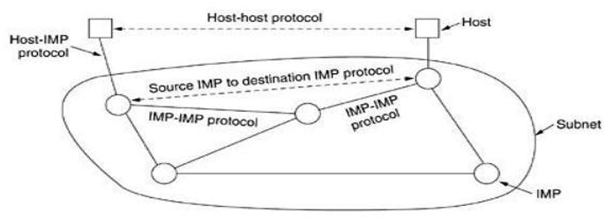The subnet would comprise of the minicomputers called IMPs (Interface Message Processors) connected by the 56-kbps transmission lines. For the very high reliability, each IMP should be connected to at least two other IMPs. The subnet was to be the datagram subnet, if not so some of the lines and IMPs were damaged, messages could be automatically rerouted along alternative paths.
Each node of the network was to comprise of an IMP and a host, in the same room, linked by a short wire. A host can send messages of up to 8063 bits to its IMP, which would then split these up into packets of at most 1008 bits and forward them separately toward the destination. Each packet was obtained in its entirety before being forwarded, so the subnet was the first electronic store-and-forward packet-switching network.

ARPA then put out a tender for building a subnet. The Twelve number of companies bid for it. After going through all the proposals, ARPA selected BBN, a consulting firm in the Cambridge, Massachusetts, and in December 1968, awarded it a contract to produce the subnet and write down the subnet software. BBN chose to use specifically modified Honeywell DDP-316 minicomputers with the 12K 16-bit words of core memory as the IMPs. The IMPs did not have the disks, since the moving parts were considered unreliable. The IMPs were interlinked by 56-kbps lines leased from telephone industries. Although 56 kbps is now the option of teenagers who cannot afford ADSL or the cable, it was then the best money could buy it.
The software was divided into two the parts:
1) the subnet
2) the host. The subnet software comprises of the IMP end of the host-IMP link, the IMP-IMP protocol, and a source IMP to destination IMP protocol designed to advance reliability. The original ARPANET design is shown in the Fig.10 below. Outside the subnet, software was also required, namely, the host end of the host-IMP link, the host-host protocol, and the application software. It shortly became clear that BBN felt that when it had accepted a note on a host-IMP wire and placed it on the host-IMP wire at the destination, its purpose was done.